Joe and I took a weekend trip to Hiroshima. It took about two and half hours by the high-speed train to get there. It was a meaningful and emotional trip, one that neither of us will ever forget.
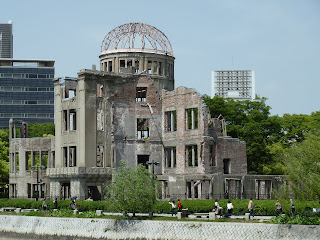
The A-Dome is the ruins of the former Hiroshima Prefecture Industrial Promotional Hall, which was destroyed by the first atomic bomb ever to be used in the history of humankind on August 6, 1945. The atomic bomb was detonated in the air at an altitude of approximately 600 meters almost right over the hall. The explosion by a single bomb claimed the lives of over 200,000 people and the city area of about a 2-km radius. This Hiroshima Peace Memorial is a World Heritage Site. It is a symbol that vows to faithfully see the abolition of nuclear weapons and everlasting world peace.
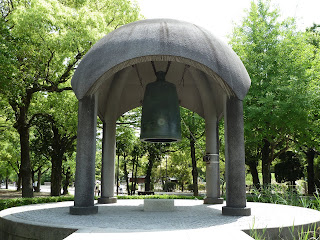
Bell of Peace. The poem reads:
"We dedicate this bell
As a symbol of Hiroshima Aspiration
Let all nuclear arms and wars be gone,
and the nations live in true peace!
May it ring to all corners of the earth
to meet the ear of every man,
for in it throb and palpitate
the hearts of its peace-loving donors.
So may you, too friends,
step forward, and toll this bell for peace!"
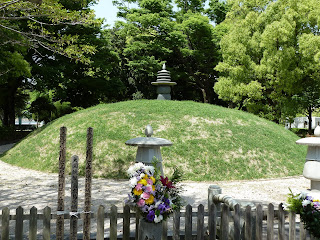
Atomic bomb memorial mound. At 8:15 on the morning of August 6, 1945, the first atomic bomb in history was dropped on Hiroshima. Here are laid the ashes of tens of thousands of its victims. Each year around August 6, memorial services are conducted by the Hiroshima Memorial Service Association in addition to other religious groups.

The Children's Peace Monument in Peace Park in Hiroshima. This monument stands in memory of all children who died as a result of the atomic bombing of Hiroshima. The monument was originally inspired by the death of Sadako Sasaki, who was exposed to the radiation from the atomic bomb at the age of two. Two years later Sadako developed leukemia that ultimately ended her life. At the top of the nine-meter monument, a bronze statue of a young girl lifts a golden crane entrusted with dreams for a peaceful future. The inscription on the stone block under the monument reads: "This is our cry. This is our prayer. For building peace in this world."
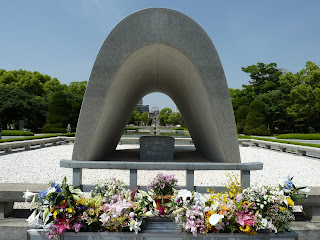
Memorial monument for Hiroshima. Directly through the monument you can see the eternal flame and beyond the flame you can see the A-Dome. The monument reads, "Let all the souls here rest in peace. For we shall not repeat the evil." This monument embodies the hope that Hiroshima, devastated on August 6, 1945 by the world's first atomic bombing will stand forever as a city of peace. It expresses the spirit of Hiroshima - enduring grief, transcending hatred, pursuing harmony and prosperity for all, and yearning for genuine, lasting world peace.
I didn't have the heart to take any pictures inside the Hiroshima Peace Memorial Museum. It was an emotional experience to see the images inside the museum - one that we will never ever forget. It was an outside experience one will never learn from American school textbooks... the truth of the history, and how it effected the Japanese people. These images were taken off of the internet.
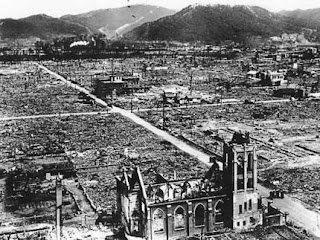
The Museum collects and displays belongings left by the victims including photos, and other materials that convey the horror of that event. Each of the items displayed embodies the grief, anger, or pain of real people. This is one of the images displayed in the museum, showing how the atomic bomb destroyed the entire city - the only thing that remained was the frame of the now named A-dome.
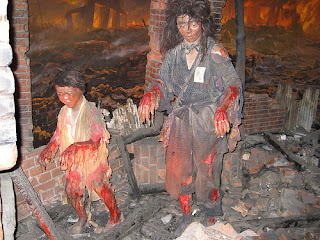
Thousands upon thousands of people lost their lives that day. Those who managed to survive, fled from the city with their burned and bloodied skin and clothes hanging off them. The poor people who did survive suffered irreparable physical and psychological damage. This exhibit had wax statues of burning people to show the realities of what happened that day - their skin hanging from their bodies, melted and burnt. There were numerous articles in the museum as well - burned lunchboxes, clothing, uniforms, dishes, melted bottles, etc. that were leftover artifacts from the remains of the people that lost their lives that day.
Despite all the horror that happened that day, and the devastation that Japan had to overcome, it's amazing to think that here we are as two American's living in a country that we destroyed only 66 years ago. The prejudice does not appear to exist - only the desire to explain the truth and promote everlasting peace.
 The Museum collects and displays belongings left by the victims including photos, and other materials that convey the horror of that event. Each of the items displayed embodies the grief, anger, or pain of real people. This is one of the images displayed in the museum, showing how the atomic bomb destroyed the entire city - the only thing that remained was the frame of the now named A-dome.
The Museum collects and displays belongings left by the victims including photos, and other materials that convey the horror of that event. Each of the items displayed embodies the grief, anger, or pain of real people. This is one of the images displayed in the museum, showing how the atomic bomb destroyed the entire city - the only thing that remained was the frame of the now named A-dome. Thousands upon thousands of people lost their lives that day. Those who managed to survive, fled from the city with their burned and bloodied skin and clothes hanging off them. The poor people who did survive suffered irreparable physical and psychological damage. This exhibit had wax statues of burning people to show the realities of what happened that day - their skin hanging from their bodies, melted and burnt. There were numerous articles in the museum as well - burned lunchboxes, clothing, uniforms, dishes, melted bottles, etc. that were leftover artifacts from the remains of the people that lost their lives that day.
Thousands upon thousands of people lost their lives that day. Those who managed to survive, fled from the city with their burned and bloodied skin and clothes hanging off them. The poor people who did survive suffered irreparable physical and psychological damage. This exhibit had wax statues of burning people to show the realities of what happened that day - their skin hanging from their bodies, melted and burnt. There were numerous articles in the museum as well - burned lunchboxes, clothing, uniforms, dishes, melted bottles, etc. that were leftover artifacts from the remains of the people that lost their lives that day.
That's why many Japanese like President Obama!
ReplyDeleteNo more A-bomb, now No more Fukushima though:(
What a great blog entry, as you were there first-hand to experience and then describe what it must have been like for the people of Hiroshima..I would love to go, but understand that it probably is a place that would be hard for you to visit again..
ReplyDeletewhat a sad day in history
ReplyDeletecan only imagine what it would be like to be there
thanks for sharing
Hiroshima is the the most beautiful city we have visited in Japan yet! We would definitely go back.
ReplyDelete